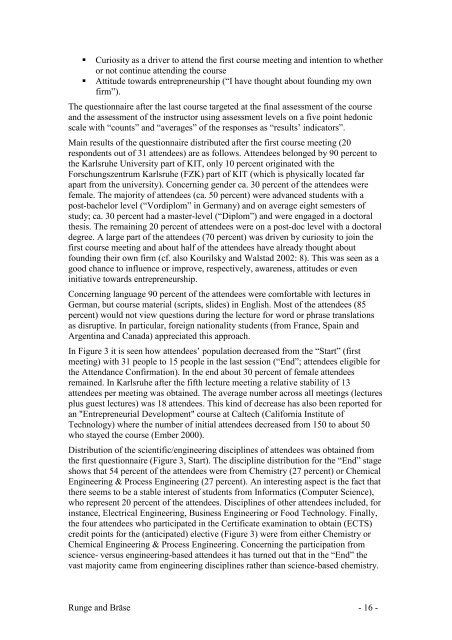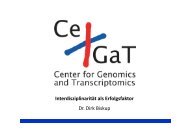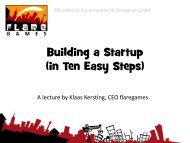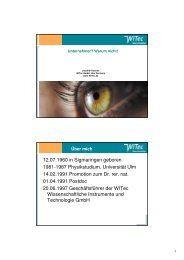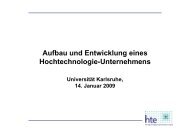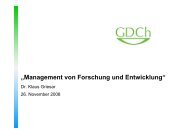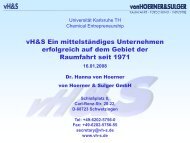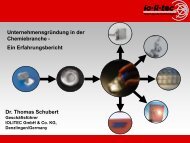Education in Chemical Entrepreneurship - KIT - Technology ...
Education in Chemical Entrepreneurship - KIT - Technology ...
Education in Chemical Entrepreneurship - KIT - Technology ...
You also want an ePaper? Increase the reach of your titles
YUMPU automatically turns print PDFs into web optimized ePapers that Google loves.
� Curiosity as a driver to attend the first course meet<strong>in</strong>g and <strong>in</strong>tention to whether<br />
or not cont<strong>in</strong>ue attend<strong>in</strong>g the course<br />
� Attitude towards entrepreneurship (“I have thought about found<strong>in</strong>g my own<br />
firm”).<br />
The questionnaire after the last course targeted at the f<strong>in</strong>al assessment of the course<br />
and the assessment of the <strong>in</strong>structor us<strong>in</strong>g assessment levels on a five po<strong>in</strong>t hedonic<br />
scale with “counts” and “averages” of the responses as “results’ <strong>in</strong>dicators”.<br />
Ma<strong>in</strong> results of the questionnaire distributed after the first course meet<strong>in</strong>g (20<br />
respondents out of 31 attendees) are as follows. Attendees belonged by 90 percent to<br />
the Karlsruhe University part of <strong>KIT</strong>, only 10 percent orig<strong>in</strong>ated with the<br />
Forschungszentrum Karlsruhe (FZK) part of <strong>KIT</strong> (which is physically located far<br />
apart from the university). Concern<strong>in</strong>g gender ca. 30 percent of the attendees were<br />
female. The majority of attendees (ca. 50 percent) were advanced students with a<br />
post-bachelor level (“Vordiplom” <strong>in</strong> Germany) and on average eight semesters of<br />
study; ca. 30 percent had a master-level (“Diplom”) and were engaged <strong>in</strong> a doctoral<br />
thesis. The rema<strong>in</strong><strong>in</strong>g 20 percent of attendees were on a post-doc level with a doctoral<br />
degree. A large part of the attendees (70 percent) was driven by curiosity to jo<strong>in</strong> the<br />
first course meet<strong>in</strong>g and about half of the attendees have already thought about<br />
found<strong>in</strong>g their own firm (cf. also Kourilsky and Walstad 2002: 8). This was seen as a<br />
good chance to <strong>in</strong>fluence or improve, respectively, awareness, attitudes or even<br />
<strong>in</strong>itiative towards entrepreneurship.<br />
Concern<strong>in</strong>g language 90 percent of the attendees were comfortable with lectures <strong>in</strong><br />
German, but course material (scripts, slides) <strong>in</strong> English. Most of the attendees (85<br />
percent) would not view questions dur<strong>in</strong>g the lecture for word or phrase translations<br />
as disruptive. In particular, foreign nationality students (from France, Spa<strong>in</strong> and<br />
Argent<strong>in</strong>a and Canada) appreciated this approach.<br />
In Figure 3 it is seen how attendees’ population decreased from the “Start” (first<br />
meet<strong>in</strong>g) with 31 people to 15 people <strong>in</strong> the last session (“End”; attendees eligible for<br />
the Attendance Confirmation). In the end about 30 percent of female attendees<br />
rema<strong>in</strong>ed. In Karlsruhe after the fifth lecture meet<strong>in</strong>g a relative stability of 13<br />
attendees per meet<strong>in</strong>g was obta<strong>in</strong>ed. The average number across all meet<strong>in</strong>gs (lectures<br />
plus guest lectures) was 18 attendees. This k<strong>in</strong>d of decrease has also been reported for<br />
an "Entrepreneurial Development" course at Caltech (California Institute of<br />
<strong>Technology</strong>) where the number of <strong>in</strong>itial attendees decreased from 150 to about 50<br />
who stayed the course (Ember 2000).<br />
Distribution of the scientific/eng<strong>in</strong>eer<strong>in</strong>g discipl<strong>in</strong>es of attendees was obta<strong>in</strong>ed from<br />
the first questionnaire (Figure 3, Start). The discipl<strong>in</strong>e distribution for the “End” stage<br />
shows that 54 percent of the attendees were from Chemistry (27 percent) or <strong>Chemical</strong><br />
Eng<strong>in</strong>eer<strong>in</strong>g & Process Eng<strong>in</strong>eer<strong>in</strong>g (27 percent). An <strong>in</strong>terest<strong>in</strong>g aspect is the fact that<br />
there seems to be a stable <strong>in</strong>terest of students from Informatics (Computer Science),<br />
who represent 20 percent of the attendees. Discipl<strong>in</strong>es of other attendees <strong>in</strong>cluded, for<br />
<strong>in</strong>stance, Electrical Eng<strong>in</strong>eer<strong>in</strong>g, Bus<strong>in</strong>ess Eng<strong>in</strong>eer<strong>in</strong>g or Food <strong>Technology</strong>. F<strong>in</strong>ally,<br />
the four attendees who participated <strong>in</strong> the Certificate exam<strong>in</strong>ation to obta<strong>in</strong> (ECTS)<br />
credit po<strong>in</strong>ts for the (anticipated) elective (Figure 3) were from either Chemistry or<br />
<strong>Chemical</strong> Eng<strong>in</strong>eer<strong>in</strong>g & Process Eng<strong>in</strong>eer<strong>in</strong>g. Concern<strong>in</strong>g the participation from<br />
science- versus eng<strong>in</strong>eer<strong>in</strong>g-based attendees it has turned out that <strong>in</strong> the “End” the<br />
vast majority came from eng<strong>in</strong>eer<strong>in</strong>g discipl<strong>in</strong>es rather than science-based chemistry.<br />
Runge and Bräse - 16 -


